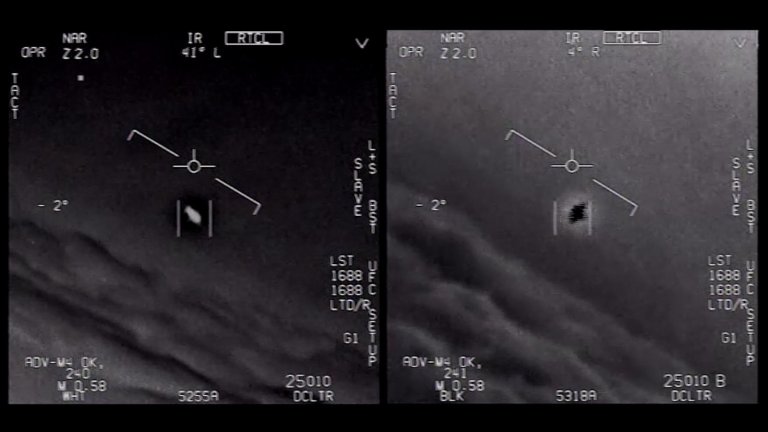Why The Pentagon Needs to Address UFO Disinformation
Many of the most popular UFO myths boil down to confusion and misinformation. But was any of it intentional?

In 1988, a recently-retired U.S. Air Force Office of Special Investigations (OSI) agent claimed on live television that the government was working with aliens at a secret base in the Nevada desert called Area 51 and that the “extraterrestrials have complete control of this base.” In the program, the producers blacked out the OSI agent’s face, and he went by the codename “Falcon.”
The agent’s actual name is Richard Doty. It’s listed on the IMDb page for the show. Doty has admitted that during his career as an OSI agent, beginning in 1980, he had been sharing disinformation about aliens and UFOs with the UFO community. Within weeks of the airing of the live UFO program, a man in Nevada named Bob Lazar approached reporters in Las Vegas claiming he had worked on alien spacecraft at Area 51. Despite lacking evidence, Lazar’s claims made headlines, and Area 51, then one of United States’ most secret military bases, quickly became its most famous.
Stories like this leave me wondering how much of the UFO mythos is disinformation created by the U.S. government and why. It sounds like another UFO conspiracy theory, but Congress is interested in this question also. They require that the Pentagon’s current UAP investigation program, the All-Domain Anomaly Resolution Office (AARO), produce a report that includes “the key historical record of the involvement of the intelligence community with unidentified anomalous phenomena, including… any efforts to obfuscate, manipulate public opinion, hide, or otherwise provide incorrect unclassified or classified information about unidentified anomalous phenomena or related activities.”
Is there any reason to believe the U.S. government has deceived the public about UFOs? Mr. Doty’s story is not well known, but the CIA has admitted to deceiving the public about UFOs in a study published by the CIA journal Studies in Intelligence titled “A Die-hard Issue: CIA’s Role in the Study of UFOs, 1947–1990.”
According to the study, much like today, credible UFO sightings in the late 1940s and early 1950s brought media attention to the topic. This pressured the U.S. Air Force into creating UFO investigation programs and the CIA to discreetly monitor the situation. The CIA didn’t want attention to the fact that it was monitoring UFO reports and interfacing with the U.S. Air Force on the matter, so both organizations chose to lie about it. The report states, “This concealment of CIA interest contributed greatly to later charges of a CIA conspiracy and cover-up.”
The problem worsened in the late ’50s when testing of U-2 spy planes began. The aircraft flew much higher than any others at the time, and the prototypes were highly reflective, causing a spike in reports to the USAF UFO research program at the time, Project Blue Book. The CIA later estimated half of the UFO reports during this time were due to U-2 aircraft. The report claims, “This led the Air Force to make misleading and deceptive statements to the public in order to allay public fears and to protect an extraordinarily sensitive national security project.”
The report also covers the CIA’s involvement with a University of Colorado review of UFO information in the late ’60s, which led to the USAF closing Project Blue Book and exiting public UFO research completely. Both agencies decided to keep the CIA’s involvement in the report hidden.
Even Roswell was a cover-up, albeit not of the extraterrestrial kind. Unfortunately, the first volume of the AARO report whitewashes this event. According to the AARO report, in the 1990s, “USAF’s research did not locate or develop any information that indicated the ‘Roswell Incident’ was a UFO event, nor was there any ‘cover-up’ by the USG.”
It goes on to explain how the USAF found that the debris collected in the desert in 1947 was part of a classified project to listen for Russian nuclear testing called Project Mogul. It does not include the fact that the USAF’s research also found that the person in charge of researching the material, General Roger Ramey, had taken it upon himself to hide that the debris was part of a classified project. Instead, he told the press they had found an ordinary weather balloon and switched out the actual debris before taking press photos.
According to the 1995 USAF Roswell report, “the Air Force did not find documented evidence that Gen. Ramey was directed to espouse a weather balloon in his press conference, he may have done so because he was either aware of Project MOGUL and was trying to deflect interest from it, or he really perceived the material to be a weather balloon based on the identification from his weather officer, Irving Newton.”
Ramey’s Chief of Staff, Colonel Thomas DuBose, who can be seen in one of the photos, claimed in an affidavit, “the material shown in the photographs taken in Gen. Ramey’s office was a weather balloon. The weather balloon explanation for the material was a cover story to divert the attention of the press.”
DuBose does not claim to have seen or known anything about the material that the USAF found. Still, Ramey’s switching out of the material and DuBose’s statement help fuel Roswell’s conspiracy theories to this day.
This brings us back to Doty, who is the first source of the claim that the USAF took alien bodies to Area 51. He did so in a document claiming a cabal of influential people inside and outside of the government controls UFOs and alien secrets. If this sounds like the X-Files, it’s because the show was allegedly based on Doty’s stories.
In late 1980, Doty worked at Kirtland Air Force base in Albuquerque, New Mexico. Only months after beginning his position as an OSI agent, a local technical equipment vendor and paranormal enthusiast, Paul Bennewitz, claimed to be getting images and signals from UFOs over the base. According to documents I and others have received via Freedom of Information Act (FOIA) requests, Doty and another agent looked at what Bennewitz had found but didn’t see anything worth researching.
Doty claims that someone in the Defense Intelligence Agency (DIA) approached him soon after meeting with Bennewitz. Doty refers to the DIA agent with the codename “Falcon”—the same name he later used on the TV show mentioned earlier. According to Doty, Falcon wanted Doty to feed disinformation to Bennewitz and make Bennewitz believe what he saw was aliens. Falcon said Bennewitz was capturing signals and videos of top-secret activity at the base, and the disinformation was intended to throw off Bennewitz and any Russian spies that might be monitoring him.
There is no evidence that Falcon exists or that Doty was ordered to conduct his disinformation program against Bennewitz, but it was effective and drove Bennewitz into a dangerous mental state. Even worse, the disinformation Doty spread and its amplification by the X-Files has created mythos that may even fool government insiders.
The FBI investigated some of Doty’s documents and asked the U.S. Air Force what they knew. The documents were returned with the word “BOGUS” written on them in thick black marker. But the question isn’t whether they are bogus. The question is why they came from an active OSI agent—a question still unanswered.
In an op-ed for Scientific American earlier this year, former AARO Chief Sean Kirkpatrick wrote: “…our efforts were ultimately overwhelmed by sensational but unsupported claims that ignored contradictory evidence yet captured the attention of policy makers and the public, driving legislative battles and dominating the public narrative.”
I agree with Kirkpatrick regarding the negative effect “sensational but unsupported claims” are having on moving UAP research forward. However, the government has to be open and cooperative as well and needs to investigate and take responsibility for its role in UAP disinformation.
